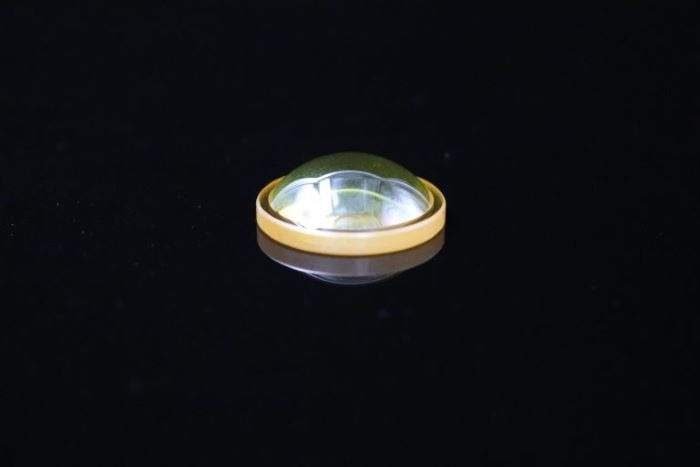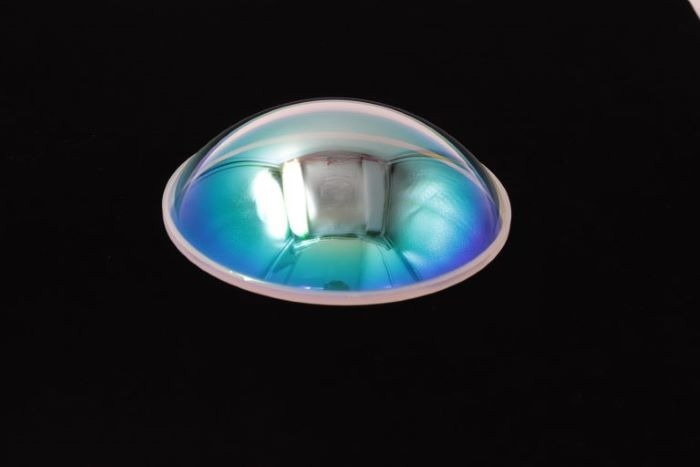Accomplishing transparency is the first step toward operationalizing optical camera systems. Flanged camera optical glass domes are distinguished by their exceptional optical invisibility. Even the most discerning eye or camera lens cannot detect their presence. This status is defined as near-zero “wavefront error” in optical terms, representing an innovative standard of precision and clarity.
Avantier’s solution effortlessly merges optical camera domes with proprietary flange mounting technology, making them sturdy and durable. They also easily adjust to existing systems, guaranteeing resilience in even the toughest conditions.
Due to flanged optical glass domes that can resist pressures up to thousands of PSI, camera systems are entering a new age of optical clarity and durability.

Image Credit: Avantier Inc.
Common Issues with Flanged Molded Camera Glass Domes
Source: Avantier Inc.
| |
|
| Overall Distortion |
This type of distortion arises from poor glass dome design, variations in wall thickness, and material inhomogeneity. For camera systems, distortion becomes even more problematic. |
| Localized Distortion & Speckle |
These issues result from mold marks, bubbles, pits, scratches, and other local defects. |
| Haziness |
Haziness occurs due to micro-surface abrasion, devitrification, and low-quality bulk material. |
| Reduced Transmission |
Poor-quality material leads to signal attenuation, exacerbating reduced transmission. |
| Color Shift & Chromatic Aberration |
Non-neutral material color filtering and color dispersion cause color shifts and aberrations. |
| Parallax Error |
This error stems from overall system design, including camera positioning. |
| Fresnel Reflections (Fresnel Losses) |
A natural surface effect that reduces transmission and causes multiple images and signal loss. However, good system design and anti-reflective coatings can mitigate this. |
| Mounting Issues: |
A poorly designed flange mounting system poses risks to costly equipment. With a proven track record, Rayotek’s flanged glass domes are securely mounted and fully sealed against hostile environments. |
Long-Term Reliability Issues in Designing a Flanged Molded Optical Glass Dome
Source: Avantier Inc.
| |
|
| Radiation (Light) Degradation |
Prolonged exposure to sunlight and intense lighting can lead to yellowing and solarization of dome materials. |
| Thermal Failure & Degradation |
When subjected to excessive heat, plastic domes become brittle and lose strength and optical clarity. Glass domes, if made from the wrong material, can crack or even explode due to thermal shock. |
| Mechanical Stresses |
Impacts, explosions, abrasion, and other environmental hazards can compromise optical and mechanical performance. |
| Flange Seal Failure |
The strength of a mounted glass dome relies on the seal to the flange. Equally critical is the reliability and durability of the seal between the housing and the glass dome. |
Addressing the aforementioned quality and reliability challenges involves solutions spanning straightforward, financially efficient measures to more sophisticated and costly ones. Designers must understand the application’s fundamental needs and are conscious of the limits expounded by imaging and image processing equipment.
Avantier’s method involves understanding requirements and constraints, building custom-made solutions, optimizing technology use, offering value to customers, and constantly enhancing its products to resolve quality and reliability issues effectively.

Image Credit: Avantier Inc.
Selecting the Ideal Glass Dome
Multiple factors must be considered when choosing the ideal glass dome for a specific use case:
- Understand Application Requirements: Before selecting a dome, thoroughly examine any application requirements to avoid unnecessary costs. Excessive specifications often lead to excessive expenditures. Identify the necessary features without sacrificing performance.
- Performance Constraints of Imaging System: Ensure the dome does not inhibit the imaging system’s function. Do not go beyond what is necessary to reduce overspending. Ensure the dome’s specifications align with the imaging system’s capabilities.
- Manufacturing Method Impact: The manufacturing approach significantly impacts optical and mechanical performance and manufacturing costs.
- Ground and polished domes are accurate but expensive, and the manufacturing process can be lengthy.
- Molded glass domes can be slumped or press-molded.
- Press-molded domes can display mold marks and distortion, making them more compatible with non-optical use cases.
- Slump-molded glass domes provide higher surface quality at a lower cost than ground and polished domes.
- Material Selection: The chosen material significantly impacts optical performance and durability.
- Plastic is cheap but susceptible to degradation and scratching over time, especially in harsh environments.
- Slump-molded glass domes are usually constructed from superior-quality glass, providing durability and optical clarity.
- Flange Material and Sealing Process: Consider chemical exposure, pressure, radiation, and temperature when choosing appropriate flange materials. Avantier provides specialized expertise in custom-built sealing processes for unique use cases, guaranteeing the highest performance without unnecessary expenses.
Conclusion
Selecting the correct glass dome for a given use case requires a deep understanding of specific needs to balance performance and cost properly. Factors like manufacturing technique, material selection, and flange sealing are critical in maintaining optical clarity, durability, and resilience across multiple environments.
Avantier is dedicated to excellence in building flanged camera optical glass domes, using premium materials and dynamic manufacturing methods for unmatched optical integrity and long-term reliability. Prioritizing these important points will make selecting the best glass dome easier according to imaging system requirements.

This information has been sourced, reviewed, and adapted from materials provided by Avantier Inc.
For more information on this source, please visit Avantier Inc.